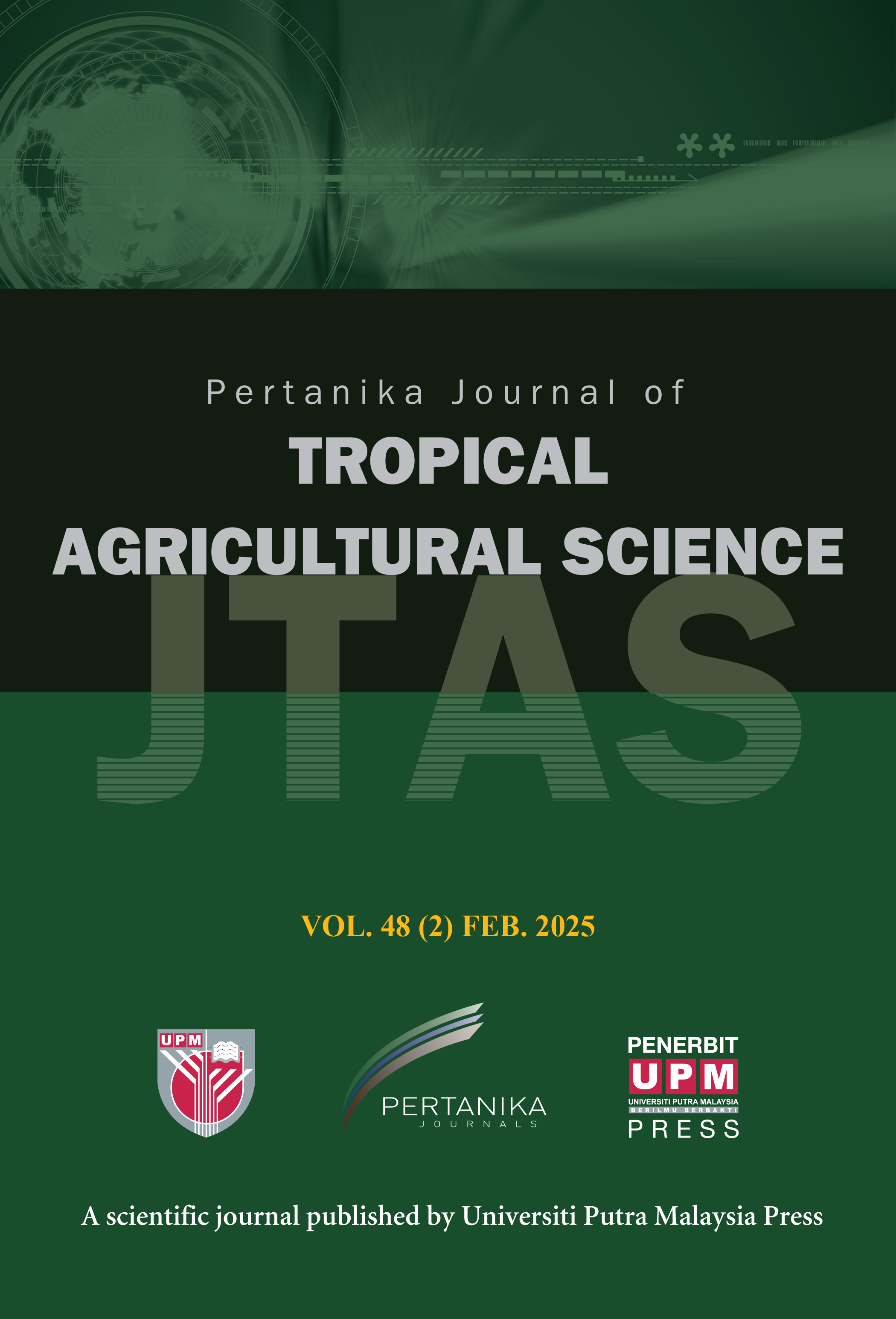PERTANIKA JOURNAL OF TROPICAL AGRICULTURAL SCIENCE
e-ISSN 2231-8542
ISSN 1511-3701
J
J
Pertanika Journal of Tropical Agricultural Science, Volume J, Issue J, January J
Keywords: J
Published on: J
J
-
Akaike, H. (1974). A new look at the statistical model identification. Automatic Control IEEE Trans, 19, 716–723. https://doi.org/10.1109/TAC.1974.1100705
-
Alzayat, F., Almahrazi, R., Arshad, A., Fathi, K., Albaili, M., dogan, A., Asiri, A., Hadi, F., & Jassim, A. (2011). Technical report of the Gulf Scale for Multiple Mental Abilities (GMMAS). Arab Gulf University.
-
Baker, F. B., & Kim, S. (2017). The basics of Item Response Theory using R. Springer. https://doi.org/10.1007/978-3-319-54205-8
-
Carroll, J. B. (1993). Human cognitive abilities. Cambridge University Press. https://doi.org/10.1017/cbo9780511571312
-
Chalmers, R. P. (2012). mirt: A Multidimensional Item Response Theory Package for the R environment. Journal of Statistical Software, 48(6). https://doi.org/10.18637/jss.v048.i06
-
Chen, W. H., & Thissen, D. (1997). Local dependence indexes for item pairs using Item Response Theory. Journal of Educational and Behavioral Statistics, 22(3), 265–289. https://doi.org/10.3102/10769986022003265
-
Deary, I. J. (2020). Intelligence: A very short introduction. Oxford University Press. https://doi.org/10.1093/actrade/9780198796206.001.0001
-
Edelen, M. O., & Reeve, B. B. (2007). Applying Item Response Theory (IRT) modeling to questionnaire development, evaluation, and refinement. Quality of Life Research, 16(S1), 5–18. https://doi.org/10.1007/s11136-007-9198-0
-
Embretson, S. E., & Reise, S. P. (2000). Item Response Theory for psychologists. Psychology Press. https://doi.org/10.4324/9781410605269
-
Fu, Q. (2010). Comparing Accuracy of parameter estimation using IRT Models in the presence of guessing [Unpublished doctoral dissertation]. University of Illinois at Chicago.
-
Gao, S. (2011). The exploration of the relationship between guessing and latent ability in IRT models [Unpublished doctoral dissertation]. University of Southern Illinois.
-
Gill, P., Marrin, S., & Phythian, M. (2020). Developing intelligence theory: New challenges and competing perspectives. Routledge. https://doi.org/10.4324/9780429028830
-
Haladyna, T. M., & Downing, S. M. (2005). Construct-irrelevant variance in high-stakes testing. Educational Measurement: Issues and Practice, 23(1), 17–27. https://doi.org/10.1111/j.1745-3992.2004.tb00149.x
-
Hallowell, D., Okamoto, Y., Romo, L. F., & La Joy, J. R. (2015). First-graders’ spatial-mathematical reasoning about plane and solid shapes and their representations. Zdm – Mathematics Education, 47(3), 363–375. https://doi.org/10.1007/s11858-015-0664-9
-
Hunt, E. (2011). Human intelligence. Cambridge University Press.
-
Jabrayilov, R., Emons, W. H. M., & Sijtsma, K. (2016). Comparison of classical test theory and item response theory in individual change assessment. Applied Psychological Measurement, 40(8), 559–572. https://doi.org/10.1177/0146621616664046
-
Jensen, A. R. (1998). The G factor: The science of mental ability. Praeger. https://www.amazon.com/Factor-Science-Evolution-Behavior Intelligence/dp/0275961036
-
Keenan, T. D., & Meenan, C. E. (2014). Using cognitive predictors to identify response to intervention groups. Journal of Learning Disabilities, 47(4), 348–360.
-
Li, Y., Zhang, Y., Dai, D., & Hu, W. (2022). The role of cognitive abilities and self-control in high school students’ academic performance: Evidence from Chinese compulsory education. Journal of Educational Psychology, 114(7), 1553-1566. https://doi.org/10.1037/edu0000701.
-
Lohman, D. F. (2005). The role of nonverbal ability Tests in identifying academically gifted Students: An Aptitude perspective. Gifted Child Quarterly, 49(2), 111–138. https://doi.org/10.1177/001698620504900203
-
Matarneh, A. J., & Oalla, B. M. (2018). Differential item functioning of the test subjects in the English language course administered to students of Mu’tah University. Journal of Educational and Psychological Sciences, 19(2), 449-475. https://doi.org/10.12785/jeps/190215
-
National Council of Teachers of Mathematics. (2023). Principles and standards for school mathematics. https://www.nctm.org/Standards-and-Positions/Principles-and-Standards/
-
Reckase, M. D. (1979). Unifactor latent trait models applied to multifactor tests: Results and implications. Journal of Educational Statistics, 4(3), 207–230. https://doi.org/10.2307/1164671
-
Reeve, B. B., Hays, R. D., & Bjørner, J. B. (2007). Psychometric evaluation and calibration of health-related quality of life item banks. Medical Care, 45(5), S22–S31. https://doi.org/10.1097/01.mlr.0000250483.85507.04
-
Salgado, J. F. (2002). The big five personality dimensions and counterproductive behaviors. International Journal of Selection and Assessment, 10(1 & 2), 117–125. https://doi.org/10.1111/1468-2389.00198
-
Schwarz, G. (1978). Estimating the dimension of a model. Annals of Statistics, 6(2). https://doi.org/10.1214/aos/1176344136
-
Shea, D. L., Lubinski, D., & Benbow, C. P. (2001). Importance of assessing spatial ability in intellectually talented young adolescents: A 20-year longitudinal study. Journal of Educational Psychology, 93(3), 604–614. https://doi.org/10.1037/0022-0663.93.3.604
-
Smits, N., Cuijpers, P., & Van Straten, A. (2011). Applying computerized adaptive testing to the CES-D scale: A simulation study. Psychiatry Research, 188(1), 147–155. https://doi.org/10.1016/j.psychres.2010.12.001
-
St Clair-Thompson, H., & Gathercole, S. E. (2006). Executive functions and achievements in school: Shifting, updating, inhibition, and working memory. Quarterly Journal of Experimental Psychology, 59(4), 745–759. https://doi.org/10.1080/17470210500162854
-
Subali, B., Kumaidi, B., & Nonoh, S. A. (2021). The comparison of item test characteristics viewed from classic and modern test theory. International Journal of Instruction, 14(1), 647-660. https://doi.org/10.29333/iji.2021.14139a
-
Suleiman, S. (2010). The relationship between spatial ability and academic achievement in mathematics among sixth grade students in UNRWA schools [Unpublished doctoral dissertation]. Islamic University of Gaza.
-
Tanaka, J. S., & Huba, G. J. (1985). A fit index for covariance structure models under arbitrary GLS estimation. British Journal of Mathematical and Statistical Psychology, 38(2), 197–201. https://doi.org/10.1111/j.2044-8317.1985.tb00834.x
-
Thurstone theory of intelligence: Exploring multiple factors. (2023). Testbook. https://testbook.com/ias-preparation/thurstone-theory-of-intelligence
-
Uttal, D. H., Meadow, N. G., Tipton, E., Hand, L. L., Alden, A. R., Warren, C., & Newcombe, N. S. (2013). The malleability of spatial skills: A meta-analysis of training studies. Psychological Bulletin, 139(2), 352–402. https://doi.org/10.1037/a0028446
-
Verdine, B. N. (2011). Navigation experience in video game environments: Effects on spatial ability and map use skills [Doctoral dissertation, Vanderbilt University]. ProQuest. https://www.proquest.com/docview/898587381?accountid14624
-
Wai, J., Lubinski, D., & Benbow, C. P. (2009). Spatial ability for STEM domains: Aligning over 50 years of cumulative psychological knowledge solidifies its importance. Journal of Educational Psychology, 101(4), 817–835. https://doi.org/10.1037/a0016127
-
Weckbacher, L. M., & Okamoto, Y. (2014). Mental rotation ability in relation to self-perceptions of high school geometry. Learning and Individual Differences, 30, 58–63. https://doi.org/10.1016/j.lindif.2013.10.007
-
Wong, E. H., Rosales, K. P., & Looney, L. (2023). Improving cognitive abilities in school-age children via computerized cognitive training: Examining the effect of extended training duration. Brain Sciences, 13(12), Article 1618. https://doi.org/10.3390/brainsci13121618
-
Yen, W. M. (1993). Scaling performance assessments: Strategies for managing local item dependence. Journal of Educational Measurement, 30(3), 187–213. https://doi.org/10.1111/j.1745-3984.1993.tb00423.x
ISSN 1511-3701
e-ISSN 2231-8542




